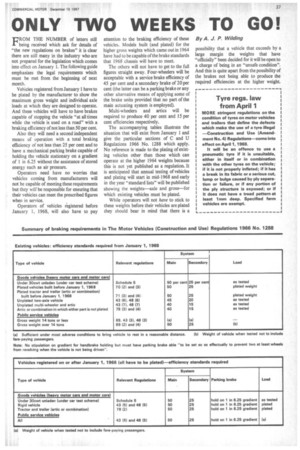ONLY TWO WEEKS TO GO!
Page 39

If you've noticed an error in this article please click here to report it so we can fix it.
By A. J. P. Wilding FROM THE NUMBER of letters still being received which ask for details of "the new regulations on brakes" it is clear there are still many in the industry who are not prepared for the legislation which comes into effect on January 1. The following guide emphasizes the legal requirements which must be met from the beginning of next month.
Vehicles registered from January 1 have to be plated by the manufacturer to show the maximum gross weight and individual axle loads at which they are designed to operate. And these vehicles will have to have brakes capable of stopping the vehicle "at all times while the vehicle is used on a road" with a braking efficiency of not less than 50 per cent.
Also they will need a second independent means of operation with a total braking efficiency of not less than 25 per cent and to have a mechanical parking brake capable of holding the vehicle stationary on a gradient of 1 in 6.25 without the assistance of stored energy such as air pressure.
Operators need have no worries that vehicles coming from manufacturers will not be capable of meeting these requirements but they will be responsible for ensuring that their vehicles can meet the prescribed figures when in service.
Operators of vehicles registered before January 1, 1968, will also have to pay attention to the braking efficiency of these vehicles. Models built (and plated) for the higher gross weights which came out in 1964 have had to be capable of the brake standards that 1968 chassis will have to meet.
The others will not have to get to the full figures straight away. Four-wheelers will be acceptable with a service brake efficiency of 45 per cent and a secondary brake of 20 per cent (the latter can be a parking brake or any other alternative means of applying some of the brake units provided that no part of the main actuating system is employed).
Multi-wheelers and artics will be required to produce 40 per cent and 15 per cent efficiencies respectively.
The accompanying tables illustrate the situation that will exist from January 1 and give the particular sections of C and U Regulations 1966 No. 1288 which apply. No reference is made to the plating of existing vehicles other than those which can operate at the higher 1964 weights because this is not yet published as a regulation. It is anticipated that annual testing of vehicles and plating will start in mid-1968 and early in the year "standard lists" will be published showing the weights—axle and gross—for which existing vehicles must be plated.
While operators will not have to stick to these weights before their vehicles are plated they should bear in mind that there is a possibility that a vehicle that exceeds by a large margin the weights that have "officially" been decided for it will be open to a charge of being in an "unsafe condition". And this is quite apart from the possibility of the brakes not being able to produce the required efficiencies at the higher weight.












































































































